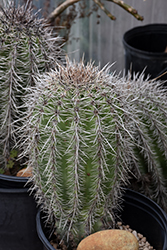Fri & Sat 8am - 8pm
Sun 8am - 7pm
Anytown, USA 12345
fax: 261.787.0463
e-mail: info@successgc.com


Plant Finder

Height: 20 feet
Spread: 3 feet
Sunlight:
![]()
Hardiness Zone: 8b
Description:
A tree-like cactus that can grow to 40 feet over a long period; has a very columnar habit, with first side arms appearing after 75 years, if at all; speed of growth is based on rainfall in area; an excellent vertical accent plant
Ornamental Features
Saguaro Cactus is a member of the cactus family, which are grown primarily for their characteristic shapes, their interesting features and textures, and their high tolerance for hot, dry growing environments. Like all cacti, it doesn't actually have leaves, but rather modified succulent stems that comprise the bulk of the plant, and which are designed to hold water for long periods of time. This particular cactus is valued for its columnar habit of growth. It has a primary spiny ribbed green stem that acts as a central leader, often with one or a few lateral 'branches' that sprout from the sides. This plant features bold clusters of fragrant creamy white cup-shaped flowers with buttery yellow eyes held atop the branches from mid to late spring. It features an abundance of magnificent ruby-red berries from early to mid summer.
Landscape Attributes
Saguaro Cactus is a large succulent evergreen plant with a columnar habit of growth. It tends to grow as a solitary entity comprised of a single primary stem, with the occasional spur extending laterally away from the plant. As a type of cactus, it has no true foliage; the body of the plant is wholly comprised of one or more spiny green stems which are prominently ribbed.
This is a relatively low maintenance plant, and should never be pruned except to remove any dieback, as it tends not to take pruning well. It is a good choice for attracting birds, bees and hummingbirds to your yard, but is not particularly attractive to deer who tend to leave it alone in favor of tastier treats. Gardeners should be aware of the following characteristic(s) that may warrant special consideration;
- Spiny
Saguaro Cactus is recommended for the following landscape applications;
- Accent
- Vertical Accent
- General Garden Use
- Naturalizing And Woodland Gardens
- Container Planting
Planting & Growing
Saguaro Cactus will grow to be about 20 feet tall at maturity, with a spread of 3 feet. It is often either grown as a solitary specimen or permitted to grow into a broader colony as part of a garden composition. It grows at a slow rate, and under ideal conditions can be expected to live to a ripe old age of 200 years or more; think of this as a heritage shrub for future generations!
This plant should only be grown in full sunlight. It prefers dry to average moisture levels with very well-drained soil, and will often die in standing water. It is considered to be drought-tolerant, and thus makes an ideal choice for a low-water garden or xeriscape application. It is not particular as to soil pH, but grows best in poor soils. It is somewhat tolerant of urban pollution. This species is native to parts of North America.
Saguaro Cactus is a fine choice for the garden, but it is also a good selection for planting in outdoor pots and containers. Its large size and upright habit of growth lend it for use as a solitary accent, or in a composition surrounded by smaller plants around the base and those that spill over the edges. It is even sizeable enough that it can be grown alone in a suitable container. Note that when growing plants in outdoor containers and baskets, they may require more frequent waterings than they would in the yard or garden.
